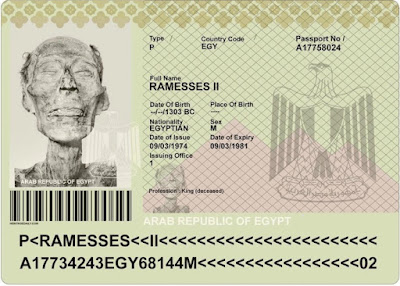Episode 27: A Passport Issued to a Mummy?!
Il-wey! Although it had been over 30 years since Akhenaten’s rule during the 18thDynasty that had cast the ancient society into turmoil, Seti I’s reign was marked by his actions to re-establish stability throughout the kingdom when his son was born in 1303 BC. Ramesses II was named after his grandfather Pharaoh Ramesses I who only ruled for a brief two years before Seti ascended to the throne during the 19thDynasty. Seti’s efforts were rewarded with defeat of Libyan troops on the western border of Egypt and following the military route eastward, Seti defeated the Hittite-controlled town of Kadesh (temporarily), which had been lost during Akhenaten’s reign. Ramesses accompanied Seti on his campaign and witnessed the glory of war.
It is believed that Ramesses was appointed as regent at the age of 14 and became the pharaoh when his father died in 1279 BC. By this time, Ramesses had developed the necessary skills to rule Egypt. Hence, his reign was marked by two campaigns. The first was the young ruler’s military activities. Like his father, he sought to restore the empire to its former glory. He engaged in numerous battles, however in 1258 BC, he took a different tactic: peace treaty. Recorded in Egyptian hieroglyphs and Akkadian, the 18-article treaty is the earliest in world history.
The second campaign involved stone and lots of it! What better to display your empire’s power than through architectural marvels? Many large monuments were built across Egypt including Abu Simbel and the Ramesseum (a mortuary temple complex). Additionally, he tasked artisans to change their carving style. Instead of carving shallow lines in the stone, Ramesses instructed that carvings should be deeply engraved so it was less likely to be repurposed and/or obliterated by subsequent rulers. His directive resulted in a plethora of temples and statues throughout the empire.
Having reigned for 66 years, Ramesses had no fewer than seven consorts which resulted in about 100 children. Perhaps this is a third, unofficial campaign? Although he was a ladies’ man, his Great Wife Nefertari was the most important as witnessed by her appearance on many of the temples’ walls and statues. Ramesses even had a temple erected to her next his at Abu Simbel. As a result, she is one of the best known ancient Egyptian women.
Ramesses lived to a ripe old age of 90 years, which would have been a rarity at that time. He was buried in the Valley of the Kings in tomb KV7. He was moved to a Royal Cache in the Theban Necropolis (west across the Nile from Luxor) and the first documented discovery was in 1881. His wrappings recorded that Ramesses had been removed from his original tomb because of looters, was re-wrapped and moved twice. Unwrapped by Gaston Maspero, striking features were revealed: an aquiline nose, a strong jaw, and auburn colored hair (or as a result of embalming). His new home became the Egyptian Museum in Cairo.
Fast forward almost a century to the mid-1970s and Egyptologists voiced concern that Ramesses’ body was deteriorating due to the presence of bacteria, which would lead to decomposition. Experts who could preserve his body were located in France. Before he could travel however, the ruler had to be issued an Egyptian passport because French law stated that persons living or dead had to have valid travel documentation, which was required to enter France. A photo of the king was taken and a valid passport was issued by the Arab Republic of Egypt in 1974. The exact date and location of his birth was unknown, which under any other circumstances would have been grounds for voiding the identification. Obviously when you are a king, even a deceased one, some concessions come with one’s lofty position.
Upon arrival at the Paris-Le Bourget Airport, Pharaoh Ramesses received full military honors. Then, he was subjected to several tests to better understand the pharaoh’s body in life. When Ramesses returned to Egypt, it is reported that Egyptian President Anwar Sadat and his wife inspected the pharaoh to make sure that the preservation had been successful (as reported by Domagoj Valjak in The Vintage News, dated January 16, 2018 – see here). And, that is how a mummy was issued a passport!
Senebti!
Banner image from Google images.



This comment has been removed by a blog administrator.
ReplyDelete